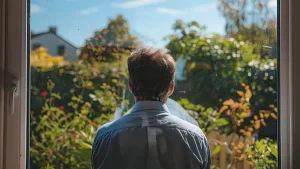
> Feeling burnt out? Subscribe to my Everyday Self-Care Newsletter for self-care tips and doable habits that support your well-being.
We breathe to live. Everyone knows it, even those who never take a single conscious breath, those who simply allow the automatic system of the body to deal with this vital action.
But what happens when we build a relationship with breath? What happens if we use breathing as a bridge to conscious and mindful living, a means of slowing and relaxing? What happens when we stop rushing, when we take one good, deep breath and in that moment we remember how good it feels to be alive?
I learned about the importance of breath when I took singing lessons in my teens and twenties. I can still hear my teacher booming breathe from your hips in his glorious resonant voice. Through months of training, I was taught to control the diaphragm and relax the shoulders, to take deep, silent breaths that fill the lungs from the bottom to the top and to extend the exhalation, using the diaphragm to gradually and consciously control the breath more and more.
Okay I admit it, in the folly of my youth, I found it incredibly boring and often skipped that part of my practice at home.
What I didn’t know at that time was the incredible importance of breathing for our health and well-being. After I stopped the vocal lessons and gave up singing professionally, the breathing exercises were no longer part of my life. It didn’t occur to me until recently that they were a wonderfully beneficial practice and I should have continued for reasons entirely separate from voice production.
In the past few years, I have begun seriously studying and practicing breathwork again, not only incorporating it into more formal meditations but also into the rhythm of daily life. This has been combined with an increasing interest in mindfulness and ‘flow.
It has taken time but I now try to maintain a regular albeit flexible routine. The more I do, the better I feel, but the adage ‘little and often’ is certainly applicable and no one should be put off by lack of time or an inability to stick to a strict routine.
So how can we incorporate effective breathwork into our daily lives? Here are a few ideas that have really helped me build a healthy and sustainable routine:
1. I take one good breath every day.
This is an absolute minimum but I notice health and well-being benefits just from this very small investment in time and effort. If you have very little time or find it difficult to commit to regular practices then just do this. Stop what you’re doing. Breathe in slowly. Breathe out slowly. Act as though executing that one single, deep, glorious breath is your only job in this whole world.
It really is so much better than nothing, this one conscious breath each day, and will often act as a seed and a motivation to gradually do more as you become more aware of your breathing and your body. In that one single, mindfully-executed breath, you are being kind to yourself. And what better habit could you create?
2. I do at least one mindful, breath-oriented meditation most days.
Usually after breakfast and/or dinner, I spend between ten and fifteen minutes concentrating on just my breath. The techniques that I use vary slightly but can be as simple as:
- concentrating on the tip of my nose, feeling the cool of the incoming air and the warmth of the outgoing as I breathe
- saying in my mind ‘I am breathing in‘ as I inhale and ‘I am breathing out‘ as I exhale. This can be combined with counting the breaths.
- following my breath into my chest and belly, feeling my abdomen rise as I breathe in and fall as I breathe out.
3. I use certain moments and daily activities to concentrate on my breathing.
I try to focus on my breathing at several moments during the day. I earmark activities, in my case brushing my teeth, doing the washing up, and other household chores. The trick is to choose moments that are regular within your day and to gradually build the habit. I also have found that it helps to slow down my movements just a fraction, to wash each cup more slowly and carefully for example; this seems to give me ‘space’ to allow the breath to flow slowly and easily. It actually makes any chore a moment to de-stress and, at the end of the activity, gain refreshment, relaxation, and clarity.
4. I try to relax and lengthen my breathing whenever I notice myself getting anxious.
As soon as I notice that I’m feeling worried, I scan my body for tension, let my shoulders drop, breath deep down into my ‘hips’ and extend my exhalation which in turn deepens the inhalation.
5. I learned the 4-7-8 breathing technique.
This powerful technique is said to help combat insomnia and anxiety. For me, it was not a quick fix but a useful daily tool. I prepare by tucking my tongue behind my top teeth and breathing out completely, making a soft whooshing sound. I then breath in through my nose to the count of four, I hold the breath for the count of seven and I breath out to the count of eight. I repeat this no more than four times. It’s a simple technique that can be practiced during the day and will slowly become more powerful through practice. If practiced regularly, it can then be used to help to relax and therefore aid in falling asleep more quickly.
I’m only human, of course, and these habits come and go a little, depending on what else is going on in my life. But I know that the times when I feel I don’t have time for this kind of breathwork are exactly the times when I really need it the most.
And when I remember that, I take my one deep breath and remind myself of just how good it feels to breathe and to be alive.


